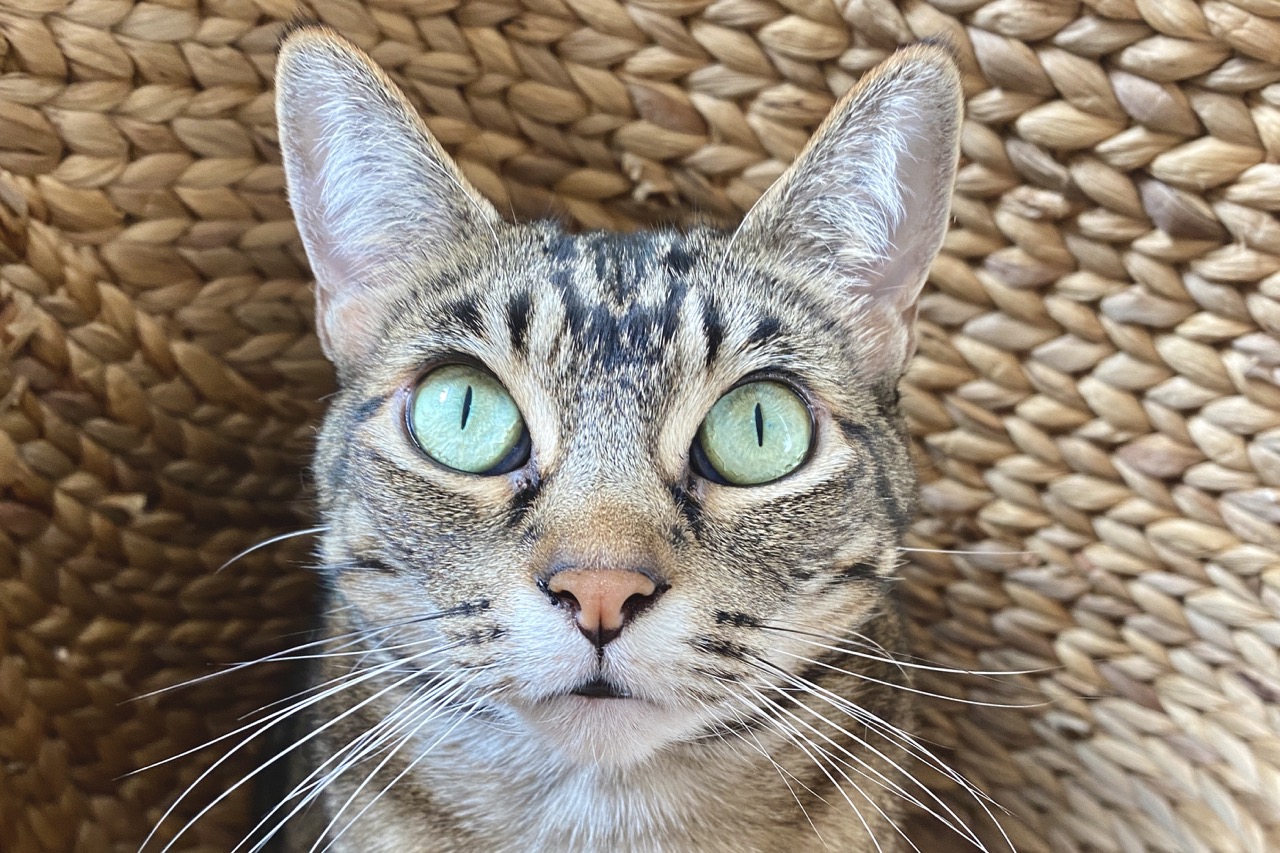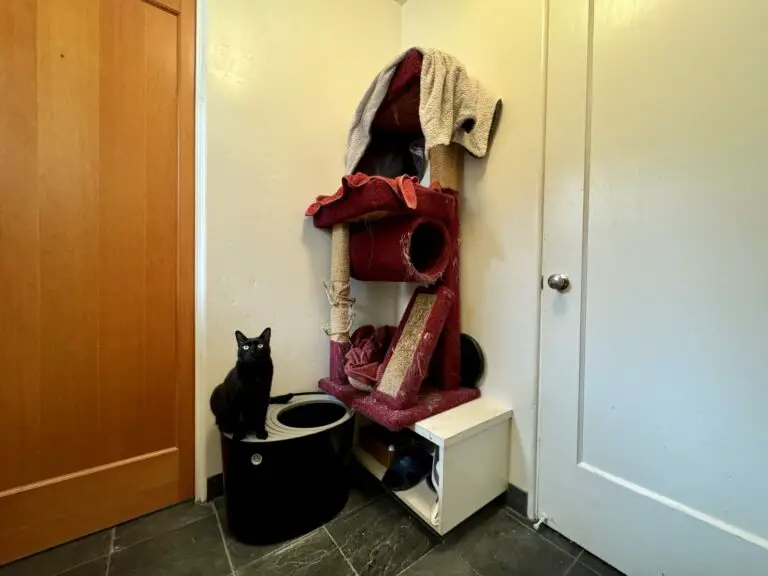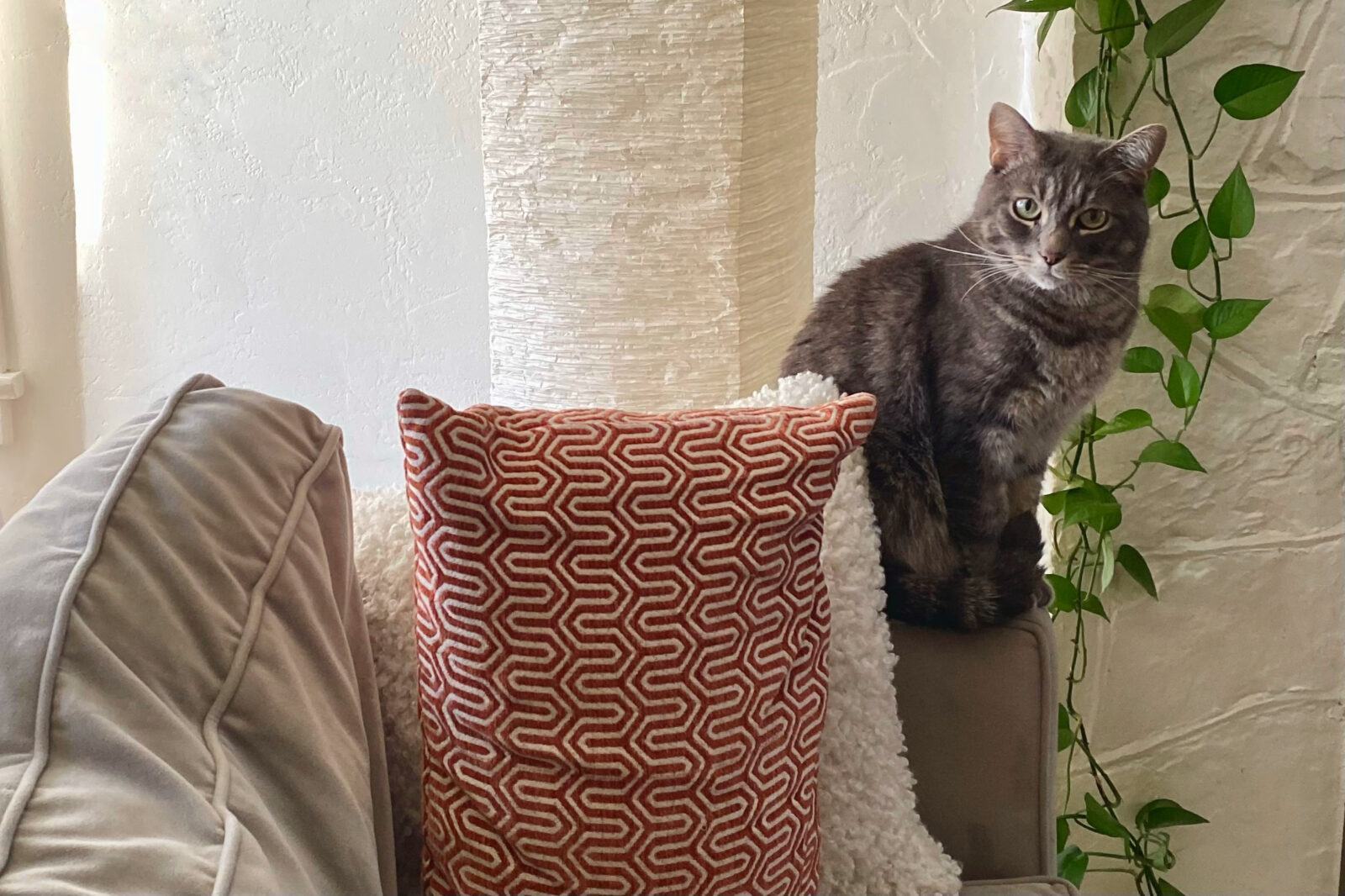Guide to the Big First Day with Your New Cat – What to Expect
Article Overview
This article is a guide for what to expect on the very first day with your new cat. It’s such an exciting moment, but it often doesn’t go like we imagined it might.
That’s because most cats find change to be very stressful. And being moved from their old home to yours is a really big change, no matter how much you prepared for your new pal.
So on the first day, your cat may exhibit a wide range of behaviors. Some may hide and rest, while others might be more curious and start to investigate every nook and cranny.
Your primary goal on this first day is to establish a sense of safety and security for your cat. This will involve setting up a designated ‘safe space’, managing introductions to family members, and beginning to establish a routine.
The first day is just the start of your cat’s acclimation process, and the patience you show now will set the tone for the trust and bond you build.

Before You Pick up Your Cat – Setting Up a Safe Space
It makes a big difference to prepare a safe room that will serve as your cat’s sanctuary. This ‘safe room’ is where your cat will initially spend most of their time, allowing them to gradually acclimate to the sights, sounds, and scents of their new home.
Choose a quiet room that can be easily closed off from the rest of the house—this could be a spare bedroom, a large closet, or any area that’s infrequently used.
Inside this room, you’ll need the essentials: a litter box placed far from the feeding area, comfortable bedding, fresh water, some toys, and a cat tree. Make sure the room is cat-proofed and free of hazards.
The safe room offers you a controlled environment to introduce your cat to their new litter, food, and water dishes without the distraction and busy-ness of a full house. By spending time with your cat in this room, you can begin to forge a bond in a space where they feel secure.
Remember, the goal is to create a calming atmosphere that speaks to their instinctual need for safety and shelter. Patience is key—some cats may need just a day to start venturing out, while others might prefer the comfort of their safe room for a bit longer.
Once you begin exploration of other parts of the house, the safe room will serve as an anchor for your cat to retreat to if frightened or overwhelmed. If it’s possible in your home, setting up the space as a permanent cat safe room has a lot of benefits down the road.
Picking Your Cat Up
The big moment has arrived! Whether you’re getting your cat from a shelter, foster, or breeder, here’s what you need to know to make the pickup as smooth as possible.
What to Bring with You
Ideally, you already have a pet carrier for your new cat’s journey home. Shelters usually have cardboard boxes meant for this purpose.
But a proper pet carrier is going to make the experience less stressful for the cat. They’re much sturdier, better ventilated, and allow the cat to see out (and you to see in). They’re also much more secure. You don’t want the cat breaking out of the box while driving, or worse, as you’re carrying the box to or from your car.
Bring a soft blanket or towel to place in the bottom of the carrier. This will give more solid footing during the car ride home.
Also, ask the shelter if there’s an object (e.g., toy) already familiar to the cat that you can bring with you. If you’ve really done your homework, you can bring a blanket, towel, or toy to the shelter in advance and have it placed with the cat you’ll be bringing home.
Finally, it’s a good idea to have identification, such as a collar with an ID tag, ready to put on in case of an escape during the transition.
Information that Should be Provided by the Shelter or Foster
The shelter staff should provide you with a wealth of information about your new cat. This includes:
- medical history
- vaccination records
- details about their behavior
- dietary preferences
- current type and brand of food
- current type and brand of litter
- any special needs the cat may have
Make sure you leave with a clear understanding of your cat’s past and current health status, as well as instructions for any ongoing care.
What to Take Home with You from the Shelter
Along with your new cat, you should take home any documentation the shelter provides, which may include adoption papers, microchip information, and a spay/neuter certificate.
If the shelter offers a starter pack, which might contain food samples or other essentials, accept it to help maintain consistency for your cat in the first few days. Otherwise, it’s a good idea to get matching food and litter from the store before or on the first day to maintain consistency during the transition.
You want to keep the trip home as short as possible, so it’s best to get this stuff before you pick up your cat, rather than on the way home with the cat in the car.
It’s also great if you can bring with you something from the shelter that already smells familiar to your cat. The ideal is to give a blanket or towel to the shelter in advance and they put it with your cat. Then you bring that same blanket home at pickup time.
The Trip Home
When transporting your cat out of the shelter, really make sure the carrier is securely closed first before heading out.
Keep the carrier secure in your vehicle, preferably strapped in with a seatbelt. Try to position the carrier so that it sits flat and parallel to the ground.
Speak softly to your cat during the journey to provide reassurance. Obviously, you want the ride to be as chill as possible, so take it easy around corners and over bumps. And go straight home if you can – you want the time in the car to be as short as possible.
Arrival Home
Once you’ve parked and before you open the door, verify that the cat is still in the carrier. If your cat got out of the carrier during the drive, they could dart out of the car when you step out. Then make sure the carrier is still securely closed before removing it from the car.
The moment you and your new cat step through the door marks a pivotal point that can shape your cat’s perception of their new environment, so it’s crucial to manage it with care and sensitivity.
Plan for this moment with others in your home to make sure all is quiet and peaceful when you first get there.
Don’t just let the cat out in the house
Resist the temptation to immediately release your cat into the vast expanse of your home. Instead, take the carrier directly to the safe room you’ve prepared in advance (see earlier section above).
Even if you haven’t prepared a safe room in advance, you should still take the carrier to a designated quiet room with a closing door and use this space as the cat safe room.
Giving your cat access to the whole house right away will most likely be overwhelming, and possibly even dangerous for the cat. And it makes it a lot harder to monitor your cat because <the whole house> is not a controlled environment.
For example, if there’s no pee in the litter box, does that mean your cat isn’t peeing at all? Or does it mean that they’re just going behind the chair in the living room? Hard to say if the cat has access to the whole house.
Not peeing at all and not peeing in the litter box are two problems you want to know about as quickly as possible, trust me! And it’s easier to know these things when the cat is confined to one small space (the safe room) as they settle in.
Introducing the safe room to your cat
Place the carrier on the floor, and give the cat a few minutes to take in all the new scents, sights, and sounds. Then open the carrier door, and give your cat the opportunity to emerge and explore at their own pace on their own terms.
It’s ok if they don’t come out right away. Some cats may dart out to discover every corner, while others may take hours or even days to venture forth.
During this initial introduction, it’s important to be present but not overbearing. Allow your cat to initiate contact, and avoid forced interactions. Speak softly or sit quietly in the room, letting your cat come to you when they feel comfortable.
Remember, this is a lot for them to take in, and they’ll need time to adjust. Your patience, understanding, and calm presence during these first few hours are key to building trust and setting the stage for a strong bond with your new cat.
Signs of stress or anxiety
The first day in a new environment is usually quite stressful for a cat, and they may well show signs of stress and anxiety. A stressed out cat will stay low to the ground when walking, usually with flattened ears and wide eyes.
One of the most common signs of stress in cats is hiding. Your new cat may seek refuge under furniture or in dark corners where they feel more secure. While this behavior is normal, prolonged hiding could suggest heightened anxiety.
Other indicators include stressed vocalizations, such as yowling, hissing, or excessive meowing. It is also normal for a cat to have little or no appetite at first when settling into a brand new home.
Additional stress behaviors include over-grooming, which can be a self-soothing action, or a lack of grooming, which may indicate your cat is too anxious for typical self-care. Restlessness, pacing, and a heightened startle response to noises or movements are also signs that your cat is feeling unsettled.
What you can do to help alleviate stress
- Keep traffic in and out of the safe room to a minimum
- Sit calmly and quietly observe from a distance
- Speak in gentle tones
- Move slowly to avoid startling
- Calmly offer a cheek rub or a treat if your cat approaches you (but don’t be offended if the offer is rejected or ignored)
- Wear clothing you don’t care a ton about. This way, you won’t react dramatically if a claw snags a thread on your pants
- Provide some cozy spots as options for hiding safely
- Don’t force any interactions
- Allow everything to happen at your cat’s own pace and initiative
By creating a calm atmosphere and allowing your cat to explore and adapt in their own time, you’ll help them overcome their initial anxiety and grow more comfortable in their new surroundings.
A word about pheromone products
You’ll find many articles on this topic that promote the use of pheromone products, such as Feliway, to reduce stress in cats. I have not included using these on the above list of what you can do because there are are several good studies that suggest these products don’t actually work better than placebo (along with some not-very-good studies that claim they do).
Using these products is probably not going to do any harm, but there’s no real evidence that indicates they work as advertised.
Hiding Behavior
When a new cat enters your home, their instinct may drive them to seek out a secluded spot where they can observe their surroundings while feeling protected.
Hiding is a natural response for cats in unfamiliar environments and is a part of their coping mechanism. It’s a behavior that allows them to gradually adjust to the new sights, sounds, and smells at their own pace.
Your cat may disappear behind furniture, crawl under beds, or even squeeze into seemingly impossible nooks. It’s important not to take this personally or as a rejection.
Instead, recognize it as a healthy and normal part of your cat’s settling in process. During this time, it’s crucial to provide your cat with the privacy they need.
Avoid the urge to pull them out from their hiding spot, as this can increase their stress and potentially damage the trust you’re trying to build.
To help your cat feel more secure, you can create a comfortable hiding place within their safe room, like a covered cat bed, a box with a hole cut out for entry, or a tunnel. These safe havens can give your cat a sense of control over their environment and can be a retreat when they feel overwhelmed.
Remember, while hiding behavior is common, it should gradually decrease as your cat becomes more comfortable in their new home. Encourage exploration and interaction with gentle coaxing using toys or treats, but always on their terms.
With time and patience, your new cat will start to venture out more and more.
The First Meal
Feeding your new cat for the first time is a significant event that can help establish trust and routine. But it’s not uncommon for cats to have a decreased appetite (or no appetite at all) when they first enter a new environment due to the stress of the change.
Plan the first meal to be quiet and calm, giving your cat a sense of security while they eat.
Before your cat arrives, find out from the shelter or previous owner what food they are accustomed to. Sudden changes in diet can cause gastrointestinal upset, so it’s best to start with what they know.
Place the food dish in a stable (floor is best), accessible location within their safe room, away from the litter box and bed. This separation of resources is important for your cat’s comfort and hygiene.
When it’s time to eat, give your cat some space. You can stay in the room, but avoid hovering or watching intently, which could create pressure. Some cats may take a few nibbles and then retreat, while others might wait until they are alone to approach their food.
If your cat doesn’t eat much or at all during the first meal, that’s ok.
Give them some time and just leave them alone with the food if they don’t eat while you’re there.
Eventually, you’ll want to be providing meals at the same times every day. But it may take a few days or even weeks to get into a rhythm.
Litter Box Familiarization
Cats are naturally clean animals and instinctively seek out a sandy or granular place to do their business, but they still need to know where their designated litter box is located in their new environment.
Place the litter box in a quiet, low-traffic area of the safe room, away from their food and water dishes, to respect your cat’s natural preferences for cleanliness and privacy.
Use the same type of litter and litter box that they were accustomed to in their previous home or shelter. A clean, unscented, clumping litter is often a good choice that many cats accept. Don’t start with a covered or top-entry litter box unless that is what they’re already used to using.
After getting settled and allowing your cat some time to explore the safe room or just decompress, gently place them in the litter box. This helps them understand its purpose and location.
They’ll probably just jump right out, and that’s fine. The initial introduction is what’s important. They may not use it immediately, but they’ll know where it is when they’re ready. Observe from a distance to ensure they can use the box undisturbed, and check for signs of use throughout the day.
If litter gets spilled, sweep it up right away. Sometimes a cat will pee wherever they find litter, including if it’s been spilled on the floor.
I like to keep the surface of the litter smoothed out so that it’s easy to tell if the cat’s been in there or not when I was out of the room. You can also comb through the litter with a scoop to monitor whether they are going both #1 and #2.
If your cat doesn’t use the litter box within the first 24 hours, it may be due to stress or not feeling secure enough yet. If they continue to avoid the litter box or exhibit any signs of distress when attempting to use it, consult with your vet to rule out any health issues.
Initial Interaction with Family Members
Introducing your new cat to the other members of your household is a delicate process that should be handled with care. It’s important to remember that each cat is unique, and their comfort with new people will vary.
On the first day, it’s best to limit interactions to ensure your cat doesn’t become overwhelmed.
Start by allowing your cat to get used to the safe room without the added stress of meeting new people. If your cat is extremely stressed (only hiding, not exploring at all), wait till Day 2 (or later if needed) to do introductions. There’s plenty of time.
Once the cat seems a bit more settled and curious about their surroundings, you can begin brief introductions.
Have family members take turns quietly entering the safe room, sitting down, and allowing the cat to approach them if they choose.
It’s really important that these meetings are on the cat’s terms. Forcing contact can be counterproductive and may even lead to fear or mistrust.
Encourage family members to speak softly and move slowly around the new cat. Quick movements and loud noises can be startling.
It can be helpful to have a few treats or a toy on hand to create a positive association, but don’t be discouraged if your cat is not yet interested in playing or eating treats during these initial encounters.
Remind everyone to be patient and give the cat plenty of space. It’s normal for a new cat to be more interested in their environment than in socializing at first.
For children, front-load them with what to expect before you bring them into the room. Make sure they understand what to do and not to do. A good first introduction can be as simple as calm presence from a distance.
With time, as your cat becomes more comfortable, they will likely become more receptive to forming bonds with each family member. The goal for the first day is simply to start building trust through gentle, respectful interactions.
When to Introduce Other Pets
Introducing your new cat to existing pets is a significant step that should be done carefully and systematically. The first day home is not the time for these introductions, as your new cat will be processing a lot of change and may already be feeling overwhelmed.
It’s important to allow time to adjust to the new environment and to feel secure in their safe room before meeting other furry family members.
During the initial adjustment period, keep your new cat and other pets separated. This separation period allows your new cat to get comfortable with the smells and sounds of the house without the added stress of face-to-face encounters. The smells and sounds are a lot all by themselves.
It also gives your existing pets time to get used to the idea that there is a new member of the family, as they can detect the newcomer’s scent under the door of the safe room.
You can start laying the groundwork for a successful introduction by exchanging bedding between your new cat and existing pets. This scent swapping helps all animals become familiar with each other’s smell before they meet.
You can also feed your new cat and resident pets on opposite sides of the safe room door to create positive associations with each other’s scents.
When it comes time to introduce your new cat to your other pets, which may be at least several days to a week after bringing them home, do so gradually and under controlled conditions.
Short, supervised visits can help gauge how your pets will react to one another and allow you to intervene if necessary. Always prioritize the comfort and safety of all animals involved, and be prepared for the process to take time.
When it comes to introducing your cat to other parts of the house, close your other pets in a room at first so that the new cat can explore without the added territorial pressure of other animals.
Interactions with dogs should be monitored closely over a long period of time. If your dog is aggressive with the cat, consider consulting a dog behaviorist or trainer for help.
Remember, go slow, don’t force anything, and have patience. Too slow is better than too fast.
Playtime and Engagement
Playtime serves multiple purposes. It can help your cat release pent-up energy, provide mental stimulation, and offer a structured way to interact with you, building trust and forming a bond.
However, it’s important to gauge your cat’s readiness for play, as they may initially be more interested in exploring or may feel too shy.
When you sense that your cat is becoming curious about their environment and seems more at ease, you can introduce a few simple toys.
Use toys that tap your cat’s natural hunting behaviors like chasing, pouncing, and batting. Interactive toys, such as a feather wand or a laser pointer, can encourage your cat to engage with you in a low-stress way.
Don’t get carried away with the laser toy though, because it’s a toy that guarantees a 0% catch rate. You want to give your cat the feeling of being a competent hunter!
Also, many people become impatient in playing with their cat. But sometimes it takes a lot of very slow movement and rustling before the pounce or chase finally happens.
Don’t bop your cat with the toy to try to get play behaviors to happen.And always supervise play with string toys or small objects that could be ingested – don’t leave them out for your cat when you’re not there to interact.
During playtime, watch your cat’s body language closely. If they seem hesitant or scared, don’t force the interaction. Instead, give them space and try again later. Some cats may only be interested in a brief play session, while others might have more endurance. Keep the initial playtimes short and positive, and end the session with a treat or words of affection before your cat loses interest. This leaves them with a feeling of satisfaction and anticipation for the next playtime.
Be patient and let your cat set the pace. The goal is not to overwhelm them with too much stimulation but to provide an opportunity for exercise and bonding.
Nighttime Arrangements
Before bedtime, ensure that your cat has everything they need in their safe room. Check that their water bowl is full, the litter box is clean, and that they have a comfortable place to sleep. Leave food out too, if your cat still hasn’t eaten.
If your cat has shown a preference for a particular spot to rest during the day, place a soft blanket or bed there to encourage them to use it at night. You can provide some other bed options as well – a blanket-lined basket or cardboard box works great.
It’s normal for cats to be more active at night, so don’t be surprised if you hear some activity. If you hear signs of distress (e.g., yowling), peek in on the cat to make sure they haven’t somehow gotten stuck or something. You can spend a couple quiet moments in there, provide reassurance, and go back to bed.
Last Meows
Remember that every cat is unique, and yours will adjust at their own pace. Patience, understanding, and a gentle approach are key. Take things as slow as they need to be – better too slow than too fast.
The first day sets the stage for building a trusting bond with your cat. And all you really need to do is show that you can be trusted and that your home is safe to be in.
Welcome to the wonderful world of cat companionship!





